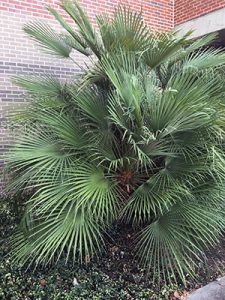Among the short list of cold-hardy palms which can tolerate temperatures below freezing, the European Fan Palm (Chamerops humilis) is the only one native to – you guessed it – Europe. It is also one of the slower-growing palms, but its curved trunk and finely-textured palmate fronds lend a distinctive architechture to the landscape.
Planting site
European fan palms have a clumping growth habit and do best in full sun but will tolerate light shade. Under ideal conditions they can grow to 15 ft. tall and 10 ft. wide. Click on the link to learn more about European fan palms.
 Nutrient requirements
Nutrient requirements
Although many of the nutrient deficiencies that are common in other palms (e.g. potassium deficiency) are not typically seen in European fan palms, they prefer well drained soils. To learn more about nutrient deficiencies and palm nutrition, click on these links: potassium deficiency and fertilizing palms.
Pests and diseases
Scale insects are the most common pests of European fan palms. Click on the link for more information on scale insects which affect palms.
Pruning
Due to its clumping growth habit, it is common for the lower fronds on European fan palms to hide the trunks. Removing lower fronds to expose the trunks can add to the plant’s aesthetic appeal. However, as mentioned previous blog posts, because palms recycle nutrients from older fronds to newer fronds, when pruning palms, green fronds should not be removed. Pruning should be reserved for spent flower stalks, immature fruit, and brown fronds. Over-pruned palms are more susceptible to nutrient deficiencies, pests and diseases.
Click on the link to learn more about pruning palms.
 1
1
